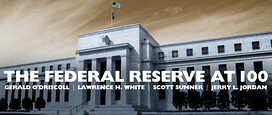Gerald O’Driscoll has posted a reply where he raises the question; “Good compared to what?” He cites Larry White’s comparison of monetary stability before and after the creation of the Federal Reserve:
1. The Fed drastically increased inflation compared to the pre-Fed period.
2. The Fed increased price-level uncertainty.
3. The Fed has not reduced real-output uncertainty.
4. The Fed has not reduced the unemployment rate, which calls into question the whole idea of full-employment mandate.
I believe this list is accurate, with the proviso that there is some uncertainty about the pre-1913 period, when data was less comprehensive than today. The next question is what do we make of this failure? Here’s a small list of my own:
1. The creation of the Fed in 1913 was a mistake.
2. It’s not obvious to me that abolishing the Fed and returning to the gold standard is a good idea. (Larry White did not take position on that issue.)
These two statements might seem a bit contradictory, and they call for an explanation. I would argue that Federal Reserve policy errors contributed to the sharp fall in nominal GDP that was the proximate cause of the Great Depression. It should be noted that America’s unit banking regulations also played an important role, by making our banking system much less stable than in countries such as Canada, which allowed branch banking. So why is it not obvious that we should return to the pre-1913 system, if our current system has done worse?
I would argue that two factors point in the other direction. First, the Fed suffered from bad timing, as it was created right on the eve of two devastating world wars. Even if the Fed had not existed it seems likely that there would have been substantial price level instability between 1913 and 1945. On the other hand, without the Federal Reserve there clearly would not have been a “Great Inflation” between 1965 and 1981. So the Fed cannot dodge all responsibility for the increased price level uncertainty.
Fortunately, there does seem to be evidence that long-run price levels are getting more predictable. I’ve been highly critical of Fed policy over the last five years, but even I cannot deny that the current price level is roughly equal to what the Fed promised 10 or 15 years ago, when they first started discussing an inflation target of 2%. That’s actually a pretty surprising result given the severity of the banking crisis and subsequent recession. My point is that institutions can improve over time and the current Fed is almost certainly more competent than the Fed of 1929 – 33 or 1965 – 81. Indeed I believe 20 year-forward price levels are now more predictable than in 1875 or 1895.
I’m very open to proposals that would replace our current discretionary policy regime with a more rules-based approach. That might mean abolishing the Fed; more likely it would involve greatly reducing the Fed’s role in monetary policy, setting a clear monetary standard, and letting markets determine the money supply and interest rates.
In a recent reply, Jerry Jordan raises a very good question:
What should “fed-watchers” be looking at to conclude that enough is enough, it is time to end “pedal to the metal” monetary actions? The Fed is backpedaling off the idea that there is a magic rate of unemployment that will signal the end is near. Scott Sumner suggests nominal GDP will signal when there is too much heat under the kettle. But then what? Nominal GDP jumped from 2.4% in QII to 4.7% in QIII, as the personal consumption price index went from a small decline in the second quarter to 1.9% increase in the third. Suppose NGDP rises further to 6% or higher in the fourth quarter? What should the FOMC instruct the trading desk to do? There is no Federal funds market; the Fed portfolio has no Treasury bills that can be sold.
My point is that there are no rules guiding central bank actions; there is no one inside or outside the Fed who can say anything meaningful about the future.
Mr. Jordan’s comments raise two important issues. First, ideas like nominal GDP targeting (my favorite approach) have less value in a world where the Fed doesn’t have a clear policy objective. If we knew where the trend line was, i.e. what sort of nominal GDP growth (levels and growth rates) that the Fed was aiming at, we could give very clear policy advice. Without such a clear objective it’s hard to know exactly what the Fed should do. I know of NGDP targeting proponents who favor more stimulus than I favor, and others who favor less. And second, the Fed needs a new policy instrument – one that does not become ineffective at the zero interest rate bound. The current policy instrument, fed funds targeting, is like having a car with steering that works most of the time, but locks up when driving on twisty mountain roads with no guard rails. Fed funds targeting seemed to work fine during periods such as the “Great Moderation” of 1985 to 2007, but it doesn’t work at all when we most need it. It’s time to reconsider the Keynesian interest rate-oriented approach to monetary policy.

